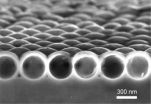(Press-News.org) CHICAGO – Although some data have suggested a possible increased risk of intussusception (when a portion of the small or large intestine slides forward into itself, like a telescope) after administration of the pentavalent rotavirus vaccine in infants, an analysis that included almost 800,000 doses administered to U.S. infants found no increased risk of this condition following vaccination, according to a study in the February 8 issue of JAMA.
"In 1999, the rhesus tetravalent rotavirus vaccine (RRV, Rotashield) was withdrawn from the U.S. market due to a significantly increased risk of intussusception following vaccination," according to background information in the article. "Since then, 2 vaccines to prevent rotavirus infection have been licensed for use in the United States: a pentavalent rotavirus vaccine (RV5, RotaTeq) in 2006 and a monovalent rotavirus vaccine (RV1, Rotarix) in 2008." Large prelicensure trials were conducted because of the prior association between RRV and intussusception, with no increased risk observed. "However, 2 recent international postlicensure evaluations [conducted in Australia, Mexico and Brazil] have observed an increased risk of intussusception in the first week after administration of the first dose of rotavirus vaccines."
Irene M. Shui, Sc.D., of Harvard Medical School and Harvard Pilgrim Health Care Institute, Boston, and colleagues reexamined intussusception risk associated with rotavirus vaccination, with a specific focus on the 1- to 7-day risk window after administration of the first dose. The study included infants 4 to 34 weeks of age, enrolled in the Vaccine Safety Datalink (VSD) who received RV5 from May 2006 – February 2010. Among the analyses the researchers performed was a comparison of the rates of intussusception in infants who had received RV5 with the rates of intussusception in infants who received other recommended vaccines without RV5 during the same period. The authors also included data on the expected number of intussusception visits based on background rates assessed prior to U.S. licensure of the RV5 (2001-2005).
From May 2006 through February 2010, 786,725 doses of RV5 were administered. Of these, 39 percent (309,844) were first doses, 33 percent second doses, and 28 percent third doses. The comparison cohort included 389,026 visits. The researchers found there were no statistically significant increased risks for intussusception in either the 1- to 30-day window or the 1- to 7-day risk window for all doses combined or in dose-specific analyses, after adjusting for age. For the 1- to 30-day window following all RV5 doses, there were 21 cases of intussusception compared with 20.9 expected cases; following dose 1, there were 7 cases compared with 5.7 expected cases. For the 1- to 7-day window following all RV5 doses, there were 4 cases compared with 4.3 expected cases; for dose 1, there was 1 case compared with a 0.8 expected case.
"Based on our analysis, an excess risk of 1 intussusception event per 65,287 RV5 vaccines following dose 1 can be reliably excluded, although we cannot rule out the possibility of a lower-level risk," the authors write.
The researchers add that the reasons for the inconsistent results between different studies are unclear. "Because intussusception is a rare event, we cannot rule out a chance finding of risk in Australia and Mexico as well as the possibility of not detecting a low-level risk in the United States and Brazil. Another possible explanation might be effect modification of the rotavirus vaccine-intussusception association by an environmental or genetic factor that differs between the populations."
"In this large, prospective postlicensure safety monitoring study of almost 800,000 doses of RV5 vaccine, with more than 300,000 first doses, we did not observe any increased risk of intussusception following RV5 vaccination. The introduction of rotavirus vaccines has had a substantial public health effect on severe rotavirus disease in U.S. infants. Although we cannot entirely exclude the possibility of a very low-level risk, the findings of our study strengthen the evidence base in favor of vaccination for effective control of severe childhood rotavirus disease," the authors conclude.
###
(JAMA. 2012;307[6]:598-604. Available pre-embargo to the media at www.jamamedia.org)
Editor's Note: This study was supported in part by the Vaccine Safety Datalink contract with AHIP, funded by the CDC. Please see the article for additional information, including other authors, author contributions and affiliations, financial disclosures, etc.
Please Note: For this study, there will be multimedia content available, including the JAMA Report video, embedded and downloadable video, audio files, text, documents, and related links. This content will be available at 3 p.m. CT Tuesday, February 7 at this link.
To contact Irene M. Shui, Sc.D., call Joan Fallon at 617-509-7458 or email joan_fallon@hphc.org.
END
CHICAGO – Short-term use of the antibiotic cefpodoxime for the treatment of women with uncomplicated cystitis (bladder infection) did not meet criteria for noninferiority for achieving clinical cure compared with ciprofloxacin, a drug in the fluoroquinolone class of antibiotics for which there have been concerns about overuse and a resulting increase in resistance rates, according to a study in the February 8 issue of JAMA. The criteria for noninferiority was if the efficacy of cefpodoxime had been shown to be within a pre-specified margin of 10 percent of the efficacy ...
For all those who have wondered where they'd be without their mothers, a study reported in the February Cell Metabolism, a Cell Press publication, puts a whole new spin on the question. Mice whose mothers pass along a mutant copy of a single imprinted gene can't keep themselves warm and die soon after leaving the comfort of the nest. The findings also reveal that the babies require a second round of heat-generating brown fat to survive.
"When that second wave is delayed, it gets them in the end," said Anne Ferguson-Smith of the University of Cambridge.
The findings ...
BUFFALO, N.Y. -- Parkinson's disease researchers at the University at Buffalo have discovered how mutations in the parkin gene cause the disease, which afflicts at least 500,000 Americans and for which there is no cure.
The results are published in the current issue of Nature Communications.
The UB findings reveal potential new drug targets for the disease as well as a screening platform for discovering new treatments that might mimic the protective functions of parkin. UB has applied for patent protection on the screening platform.
"This is the first time that human ...
The aviation accident attorneys at Baum, Hedlund, Aristei & Goldman are representing the families of the two men killed in Robinson Helicopter Company's first R66 crash which occurred on July 12, 2011 near Flandes, Colombia.
Jose Ricardo Cabrera Killed in the crash, was the owner of the R66 aircraft, Juan Pablo Gaviria, former president of the Colombian Civil Air Patrol, and Jose Ricardo Cabrera, his dear friend and a skilled helicopter pilot.
The R66 crashed shortly after take-off from Girardot Airport in Colombia. According to the National Transportation Safety ...
HOUSTON -- (Feb. 8, 2012) -- A protein kinase known as ROCK1 can exacerbate an important process called fission in the mitochondria, the power plants of cells, leading to diabetic kidney disease, said researchers from Baylor College of Medicine in a report that appears online today in the journal Cell Metabolism. (ROCK1 stands for (Rho-associated coiled-coil containing protein kinase 1.)
"We have shown the connection between ROCK1 and the progression to kidney disease through the effect of ROCK1 on the mitochondria," said Dr. Farhad R. Danesh, association professor ...
Visitors to Statuary Hall in the U.S. Capitol Building may have experienced a curious acoustic feature that allows a person to whisper softly at one side of the cavernous, half-domed room and for another on the other side to hear every syllable. Sound is whisked around the semi-circular perimeter of the room almost without flaw. The phenomenon is known as a whispering gallery.
In a paper published in Nature Communications, a team of engineers at Stanford describes how it has created tiny hollow spheres of photovoltaic nanocrystalline-silicon and harnessed physics to do ...
While epilepsy surgery is a safe and effective intervention for seizure control, medical therapy remains the more prominent treatment option for those with epilepsy. However, a new 26-year study reveals that following epilepsy surgery, nearly half of participants were free of disabling seizures and 80% reported better quality of life than before surgery. Findings from this study—the largest long-term study to date—are now available in Epilepsia, a journal published by Wiley-Blackwell on behalf of the International League Against Epilepsy (ILAE).
More than 50 million ...
###
Additional authors on the study include: Elie Ghanem, MD and Bahar Adeli, BA, both with the Rothman Institute at Jefferson.
About Thomas Jefferson University Hospitals
Thomas Jefferson University Hospitals (TJUH) are dedicated to excellence in patient care, patient safety and the quality of the healthcare experience. Consistently ranked by U.S. News & World Report among the nation's top hospitals, Thomas Jefferson University Hospital, established in 1825, has over 900 licensed acute care beds with major programs in a wide range of clinical specialties. ...
Patients who have their anterior cruciate ligament (ACL) reconstructed by surgeons who have performed less than 60 surgeries are roughly four to five times more likely to undergo a subsequent ACL reconstruction, according to a study by researchers at Hospital for Special Surgery. The study also showed that participating in a subspecialty orthopedic fellowship-training program did not improve the learning curve of young surgeons performing ACL reconstructions. The research was presented at the annual meeting of the American Academy of Orthopedic Surgeons, held Feb 7-11.
"Conventional ...
Complex systems are prone to communication breakdowns, unless there is a concerted effort to properly share necessary information. Unfortunately, the failure to communicate is all too prevalent in the delivery of medical care.
Dr. Peter Pronovost, a leading patient-safety experts at Johns Hopkins University, estimates diagnostic errors are responsible for the deaths of 40,000 to 80,000 hospitalized patients every year. That is a shockingly high number.
With so many errors being made, injured people naturally turn to the legal system seeking proper compensation. And ...

